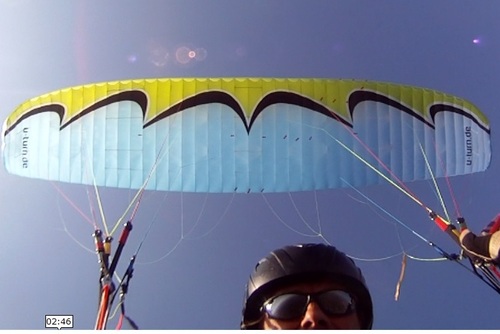U-TURN Infinity 4 M |
|||||||||||||||||||||||||||||||||||||||||||||||||||||||||||||||||||||||||||||||||||||||||||||||||||||||||||||||||||||||||||||||||||||||||||


|
|||||||||||||||||||||||||||||||||||||||||||||||||||||||||||||||||||||||||||||||||||||||||||||||||||||||||||||||||||||||||||||||||||||||||||
Instability rating |
|||||||||||||||||||||||||||||||||||||||||||||||||||||||||||||||||||||||||||||||||||||||||||||||||||||||||||||||||||||||||||||||||||||||||||
|
|||||||||||||||||||||||||||||||||||||||||||||||||||||||||||||||||||||||||||||||||||||||||||||||||||||||||||||||||||||||||||||||||||||||||||
Glider characteristics |
|||||||||||||||||||||||||||||||||||||||||||||||||||||||||||||||||||||||||||||||||||||||||||||||||||||||||||||||||||||||||||||||||||||||||||
|
Launch preparations: easy
launch characteristics: balanced, delayed climb, needs gentle guidance, minimal feedback during inflation, no braking required, slows before zenith, control check simple, low takeoff speed
asymmetric collapse: canopy colllapses at high angle to leading edge, high dynamics, total course change 270-360°, (4), fast course change rate, marked forward pitching 60-75°, (4), very high height loss 50-59 m, (4), moderate sink velocity 15-19 m/s, (2), with tendency to cravat, (4), G-Force 2,5- 2,9 G, (2)
Frontal collapse: canopy collapses with high total collapse aera, marked pitch backwards 45-60°, marked pitch forwards 45-60°, high dynamics, course change <90°, (2), variable recovery behaviour, at times with stable closed frontal collapse, at times with automatic recovery, (4), asymmetric recovery, simple pilot action required, (4), horseshoe, wingtips at front, with tendency to cravat, (4), high height loss 40-49 m, (3), low sink velocity 10-14 m/s, (1)
Spiral dives: moderate sink velocity increase, Moderate G-Force 3,5- 4.0 G, (2), Sink velocity after 720° <14 m/s, (1), High maximum sink velocity < 22 m/s, (3), sink velocity increase < 6 m/s on brake release, (2), Course change 360-540° after spiral exit, (3), high height loss during recovery 60-100 m, (3)
B-Stall: high force required, moderate pitch backwards 15-30°, moderate pitch forwards 15-30°, stable sink phase, low deformation tendency, immediate return to normal airspeed, 8-10 m/s, height loss on recovery 20-40 m
big ears: simple initiation, stable flight phase, Vsink unaccelerated 3-3,5 m/s, Vsink accelerated 4-4,5 m/s, Vunaccelerated 3-5 km/h less than trimspeed, Vaccelerated 3-5 km/h faster than trimspeed
Steering behaviour: dampened to balanced, Noticable brake pressure increase, normal stall point, easily identifiable |
|||||||||||||||||||||||||||||||||||||||||||||||||||||||||||||||||||||||||||||||||||||||||||||||||||||||||||||||||||||||||||||||||||||||||||
Notes |
|||||||||||||||||||||||||||||||||||||||||||||||||||||||||||||||||||||||||||||||||||||||||||||||||||||||||||||||||||||||||||||||||||||||||||
|
en: Asymmetric Collapse: High area, steep angled collapses with dynamic canopy reactions. Slight tendency to cravat on collapsed wing tip. Course changes indifferent. Front Collapse: Indifferent behaviour: on occasion normal re-inflation from canopy mid-point, on occasion impulsive over entire span. At lower end of weight range, tendency to enter deep stall on recovery. Spiral Dive: Easy entry. Spiral dives are easy to control. On inner brake release the sink velocity increases by 2-6 m/s. Self exiting and recovery after 360°, on occasion up to 720° where maximum sink rates of 20 m/s were reached. B-Stall: High initiation resistance. Tendency to front horseshoe for very large B-stalls. Observation recommended. Big Ears: Problem free. |
|||||||||||||||||||||||||||||||||||||||||||||||||||||||||||||||||||||||||||||||||||||||||||||||||||||||||||||||||||||||||||||||||||||||||||
Rating |
|||||||||||||||||||||||||||||||||||||||||||||||||||||||||||||||||||||||||||||||||||||||||||||||||||||||||||||||||||||||||||||||||||||||||||
|
Safety class 4 This class of paraglider reacts demandingly to one or more of the following manoeuvres: frontal collapse, asymmetric collapse or spiral dive.Demandingly means that the above manoeuvres result in marked dynamic reactions from the glider and/or large height losses. Advanced piloting skills which need to be regularly practised, together with good personal reaction times are required to safely fly this class of gliders. Basic recovery techniques for ending a manoeuvre are not sufficient to maintain control, reduce height loss to a minimum and prevent subsequent critical reactions. Pilots should be able to recognise the onset of the above manoeuvres and be able to prevent or minimise their effects through immediate and precise pilot inputs. Additional experience such as regular ground handling and SIV training is required to safely fly gliders of this class. Special training or pilot skills which exceed standard training may be required for the safe performance of emergency descent techniques. Gliders of this Safety Class are not suitable for beginners, irregular flyers or low-airtime pilots. |
|||||||||||||||||||||||||||||||||||||||||||||||||||||||||||||||||||||||||||||||||||||||||||||||||||||||||||||||||||||||||||||||||||||||||||

